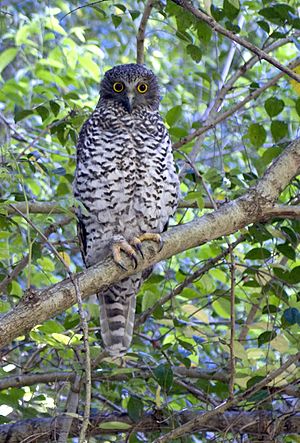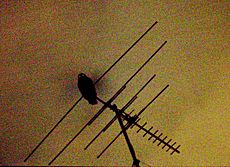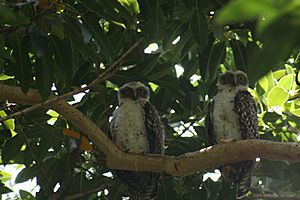Powerful owl facts for kids
Quick facts for kids Powerful owl |
|
|---|---|
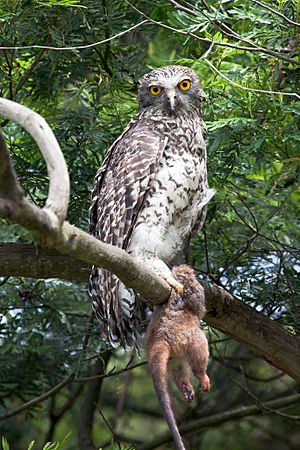 |
|
| Powerful owl holding the back half of a common ringtail possum, Lane Cove National Park, Sydney | |
| Conservation status | |
| Scientific classification | |
| Genus: |
Ninox
|
| Species: |
strenua
|
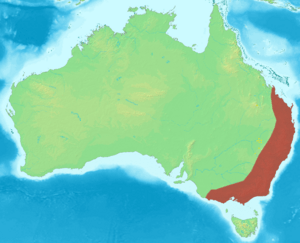 |
|
| The distribution of the powerful owl | |
The powerful owl (Ninox strenua) is the biggest owl in Australia. It lives in the southeastern and eastern parts of the country. You can find it near the coast and in the Great Dividing Range, usually not too far from the ocean. Sometimes, people also call it the powerful boobook.
This owl is a top hunter in its home area. It mostly eats mammals that live in trees, like small to medium-sized marsupials. These animals make up about three-quarters of its diet! Powerful owls usually live in old, tall forests with native trees. They are very territorial and need a large area to live in. Unlike most owls, the male powerful owl is bigger and stronger than the female. This means the male is in charge of the pair, even when it comes to sharing food.
Contents
About the Powerful Owl
The powerful owl looks a bit different from other owls. It has a long tail and a small head. This makes it look more like a hawk than a typical owl. Its strong beak and clear eyebrows also add to its hawk-like look. The feathers on its face are not very clear.
Its upper body is dark grey-brown with white spots and stripes. Its belly is white with bold grey-brown V-shaped stripes. The tail has six thin white stripes that stand out against the grey-brown. This owl has big yellow eyes. Its feet are dull yellow, with greyish feathers going down to its toes. It has very strong and heavy claws, which is why it's called "powerful." This owl is the largest of the "hawk owl" group, found in Asia and Australasia.
Size and Weight
Powerful owls are about 45 to 65 centimeters (18 to 26 inches) long. Their wings can spread from 112 to 135 centimeters (44 to 53 inches) wide. Males are a little bigger than females. Male owls usually weigh between 0.99 and 2.22 kilograms (2.2 to 4.9 pounds). Females weigh from 1.04 to 1.6 kilograms (2.3 to 3.5 pounds).
Among all owls in the world, the powerful owl is one of the longest and heaviest. It has a very long tail and wings compared to other owls of similar weight. There are no different types (subspecies) of powerful owls. Their look does not change much across different areas.
Voice of the Owl
The male powerful owl makes a deep, sad-sounding double-hoot call: whoo-hooo. Each part of the call lasts a few seconds. There is a short quiet moment between the hoots. The second hoot is usually higher pitched than the first. The female makes a similar call, but her voice is higher. When it's time to breed, you can often hear both owls calling together. Single males tend to call more often than those with a mate.
Where They Live
The powerful owl lives from Queensland in the north, down to Victoria in the south. Its range goes west into South Australia. They live in tall, wet forests and some drier woodlands. You can find them in wooded valleys, forested areas near the coast, and coastal scrub. They like wetter, heavily wooded places like sclerophyll forests.
Sometimes, they can be seen in tree farms, especially pine or native tree plantations. They also visit city and country parks and gardens. Young owls, after leaving their parents, might explore these areas before finding their own breeding territory.
Owl Behavior
Once powerful owls become adults, they usually stay with the same mate for life. They can be seen resting alone, in pairs, or in family groups of three or four. During the day, they often rest on branches in tall trees. They might even still be holding the prey they caught the night before. They use several resting spots, sometimes for many years. The powerful owl flies slowly and carefully with its large wings.
What They Eat
The powerful owl is the main night-time hunter in its forest and woodland homes. About 75% of its food comes from mammals that live in trees. This includes animals like the greater glider, ringtail possums, brushtail possums, koalas, sugar gliders, and feathertail gliders. These prey animals vary a lot in size. They can range from a tiny feathertail glider (10-15 grams) to a large koala (8.5-12 kilograms).
Even though they can kill adult koalas, powerful owls usually hunt smaller or younger animals. For example, only 15% of the ringtail possums they catch are full-grown adults. The greater glider and the common ringtail possum are common prey. The smaller sugar glider is also a favorite food. The type of prey they eat most depends on what animals are common in their area.
Powerful owls also eat large bats like the black and grey-headed flying foxes. They also hunt introduced mammals like rats, European hares, and European rabbits. They are opportunistic hunters, meaning they will eat what they can find. This includes night birds like the tawny frogmouth. They also catch birds that are resting during the day. These can be cockatoos, parrots, Australian brushturkeys, and currawongs. Sometimes, they even hunt other birds of prey. Rarely, they eat insects, lizards, and snakes.
Most of their prey is caught in trees, often high up in the branches. The owl usually glides from one branch to another, looking for prey. If the prey sees the owl too soon, a chase might happen. But many animals can escape this large predator. When the owl catches prey, its strong claws can kill it instantly. Powerful owls often tear their prey apart and eat it piece by piece. They might even eat parts of their food during the day while resting. Sometimes, they hide leftover food to eat later.
Life Cycle and Reproduction
Powerful owls breed during the Australian winter, mainly in May and June. The young owls stay in the nest until September. Powerful owls have very large breeding territories. Even when there is plenty of food, their territory is at least 800 to 1,000 hectares (2,000 to 2,500 acres). Nests of different pairs are usually 5 to 20 kilometers (3 to 12 miles) apart. Male owls have been seen fighting over females and territories.
The nest is usually a large hollow in a tree. Nests are often 10 to 15 meters (33 to 49 feet) high, but can be from 8 to 30 meters (26 to 98 feet) above the ground. The nest has decaying wood and leaves inside. The eggs are oval and dull white. Usually, two eggs are laid, but sometimes only one, and rarely three. The eggs are about 54 by 45 millimeters (2.1 by 1.8 inches). The female owl lays the eggs directly on the rotten wood floor of the tree hollow. Owls do not build a nest.
There can be up to 4 days between the first and second egg being laid. This is a very long time for an owl. The female does all the egg incubation, which lasts 36 to 38 days. The male does all the hunting and sometimes protects the nest during this time. Young powerful owls are mostly off-white with a grey-brown face mask. Their wings are grey. They look very different from adult owls.
The young owls leave the nest when they are 6 to 8 weeks old. However, they stay with their parents and are fed by them for several months. This can last 5 to 9 months, sometimes even until the next breeding season. Powerful owls have almost no natural predators. Very rarely, wedge-tailed eagles might attack them. Powerful owls have also been known to fight and kill each other over territory. Larger birds like currawongs and magpies sometimes bother them. In one case, a pair of Australian ravens attacked and killed a powerful owl, likely to protect their own nest.
Conservation Status
The powerful owl is not listed as threatened across all of Australia. However, its protection status changes from state to state:
- In Victoria, the powerful owl is listed as "threatened." An action plan is in place to help it recover.
- Victoria's 2013 list of threatened animals calls the powerful owl "vulnerable."
- In New South Wales, the powerful owl is also listed as "Vulnerable."
These owls do not do well in areas with a lot of buildings or in tree farms with only one type of tree. This is because their prey needs natural and diverse forests to live in.
- Pizzey, Graham, and Knight, Frank (2000). A Field Guide to the Birds of Australia. Angus & Robertson, 3rd edn ISBN: 0-207-19714-8
See also
 In Spanish: Nínox robusto para niños
In Spanish: Nínox robusto para niños



